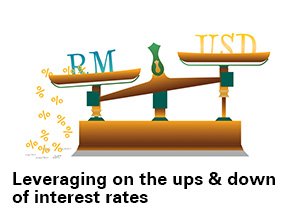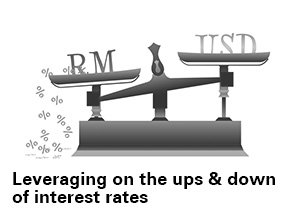
Firstly, current market conditions are different from those in previous periods when interest rates rose, so it is difficult to know what to expect in a rising interest rate environment by looking at history alone – especially given the unprecedented levels of central bank accommodation following the global financial crisis.1
Secondly, we often forget that investing in bonds generates two forms of investment returns: capital returns from changes in the bond price, and income returns from regular bond coupons or interest payments.2
More importantly, we need to remember that the “income” in fixed income drives a significant part of total bond returns over the long-term and can act as an effective cushion against shorter-term volatility of bond prices.2
Investors can better prepare for the higher interest rate environment by understanding the various ways in which different types of fixed income securities and investment vehicles may respond when rates rise, and by understanding the dynamics shaping the composition of today’s fixed income markets.1
Using Head Over Heart
If bond prices are expected to fall with rising interest rates, wouldn’t the smart move be to sell your bonds and shift the fixed income portion of your investment portfolio into cash or another asset class?4 It is a valid question and the answer is relatively simple if you take a long-term view on your investments.4
Over the past few years, equities have had one of their best runs in history while bonds haven’t been performing so well, with the exception of a few bright spots.4
So yes, bonds can lose money – which is to say that prices of bonds can fall, especially when interest rates are expected to rise.4
However, this is where diversification comes in.4 When one asset does well and another underperforms, it is called good balance, not bad allocation.4 If you take a disciplined approach to investing where your goal is to minimise risk first and maximise returns second, then your long-term strategy should simply be to remain diversified.4
Getting Regular Health Checks
Imagine your portfolio is like your body.5 To maintain optimum health, it can benefit from a strict health regimen to prevent illness and undergoing regular check-ups.5 This disciplined rebalancing and portfolio allocation can play an important role in your long-term investment strategy.5
So, what is rebalancing? In brief, it means adjusting your portfolio allocation to mitigate risks and optimise profits.5 As the market rises and falls, investors tend to have knee-jerk reactions, buying or selling to follow the trend.5 However, that market sentiment may not be the best guide for investment decisions.5
Instead, it may be more fruitful to stay the course, rather than following the crowd.5 Take the long view and stick with a disciplined rebalancing and portfolio allocation investment strategy – reset your asset allocation in a disciplined manner when the balance of equity and fixed income deviates by a set percentage.5
Over time, methodically maintaining a risk-appropriate asset allocation may enhance your risk/return trade-off versus market timing.5 And during times of market stress, the benefits of rebalancing may become more apparent.5
As part of our needs-based investment approach, HSBC’s Portfolio Allocation Service can help you ensure that your Unit Trust portfolio maintains optimum health over the long-term. To start, we work together with you to establish your portfolio’s health regimen – your financial goals, time horizons and assess your risk profile. Using this information, we can use the Portfolio Allocation Service’s reference asset mix to match a suitable asset allocation and diversification strategy for your Unit Trust portfolio that is in line with your risk profile. Then as we conduct periodical check-ups with you, we can rebalance your portfolio accordingly based on your reference asset mix.
Bonds Amidst Rising Interest Rates
Now back to the issue of potential falling bond prices in a rising interest rate environment…
As an investor, you may be considering adjusting your portfolio and contemplating selling out of bonds now over concerns of rising interest rates, and reinvesting at a later stage when bond yields have risen.6 However, that may not be the sensible course of action.6
Here are three reasons why:
1. Rising interest rates are not necessarily bad for bonds.3 As an investor, you may not lose money on bonds when interest rates go up.3
2. Rising interest rates can benefit long-term fixed income investors, with higher income usually offsetting any mark-to-market loss.6
3. Holding core bonds as part of a well-diversified portfolio can help to preserve capital, provide steady income, diversify risk and offer a hedge against equity market downturns.6
To help you understand better how rising interest rates could potentially impact your bond portfolio, let’s take a look at the table below based on Vanguard government bond Exchange Traded Funds (ETF) ranging from 2 years for the short-term bonds to 25 years for the longer term bonds.3
One of the key concepts to understand for bonds is duration.3 Duration may be thought of as interest rate sensitivity.3 A bond with long duration will move a lot in price as interest rates move, and a bond with short duration wil move less.3 Duration also indicates how long you will receive payments from the bond.3
Interest rates also clearly differ between bonds.3 Based on interest rates alone, an argument can be made for buying the Extended Duration Treasury ETF because it offers the highest interest rate or yield at 2.9% beating the 1.5% yield on the short-term bond.3 This may be true if interest rates never changed.3
However, as rates change things get more complicated.3 The Extended Duration Treasury ETF is extremely sensitive to changes in interest rates.3 That’s not necessarily a bad thing because if rates fell, then the ETF price may rise significantly.3 On the flip side, if rates go up, prices could decline.3 Historically, the longer duration ETF has moved in price more than you might expect a stable bond to do.3
We can model how much of an interest rate rise is needed for a bond to lose money by dividing the bond’s yield by its duration.3 So for a bond paying 2% interest with a 10-year duration, rates would need to rise by more than 0.2% over a year for the investor to lose money over the course of that year.3
In the example of Vanguard ETFs, we can see that an interest rate rise over +0.12% in a year would likely more than offset the interest payment received on the Extended Duration bond.3 So an investor would lose money.3 For the Short-Term Government bond ETF, it would require a +0.79% rise in rates for an investor to lose money with everything else being equal.3 Therefore, in a rising interest rate environment, the better bet would be on shorter term bonds.3
History has also shown that bond markets have been resilient following interest rate increases.1 While fixed income losses due to rising interest rates present a risk, corresponding market fears may be disproportionate to the severity and lasting impact of the losses actually incurred.1 Such fears are based partly on exaggerated expectations for the scope of future rate increases.1 Analysis shows that bond markets have tended to be resilient, bouncing back after initially incurring losses during rising rate environments.
In the long run, the risk of being underexposed to fixed income due to market timing may outweigh the risk of exposure to rising interest rates.1 Investors who maintain a longer term focus and resist the impulse to react to short-term volatility are more likely to benefit from the positive returns of fixed-income assets over time.1

The Bonds to Bet On
So, you are sufficiently convinced that bonds should still form part of your portfolio amidst rising interest rates. What next?
As you consider what bonds to invest in, remember – diversification matters.1 Different types of fixed income securities respond differently to rising interest rates.1
Sensitivity to interest rate movements can differ substantially based on duration, credit quality and type of security.1 In general, corporate bonds (both investment grade and high yield), floating-rate notes, emerging market debt, shorter term issues, and certain types of structured securities may reduce the risk of losses during periods of rising rates.1
When Treasury rates rise, credit spreads can tighten as the market supports a shift to riskier asset classes.1 This is largely because improving economic conditions typically lead to lower expected default rates for credit sectors, making them a potentially better relative value with a more favourable risk/reward tradeoff than Treasuries.1
On average, longer maturity, higher rated bond sectors underperformed during periods when Treasury yields were rising, while shorter term, lower rated, and securitised assets outperformed.1
Amundi Asset Management believes there is potential upside for Emerging Market bonds in the current interest rate environment.7 According to Amundi Asset Management, emerging market economies have seen a marked improvement in fundamentals and this is prominently reflected through low levels of indebtedness, broad economic stability and continued trend of favourable growth prospects.7
Emerging market bonds boast true global diversification, which avoids geographical and sector concentration; the asset offers up to 60 countries with diverse economic cycles and 500 corporates in different sectors.7 Emerging market bonds also present a large investable base and is growing in size with liquidity in some US$14 trillion investable universe – roughly 12% of the world’s debt market.7 According to Amundi Asset Management, emerging market bonds offer attractive yields for fixed income investors relative to other asset classes in the current low yield environment, and the economies cyclical upswing has further room to go.7
Meanwhile, HSBC Global Asset Management is positive on Asian bonds.8 According to HSBC Global Asset Management, Asian bonds offer higher yields with attractive risk adjusted returns, the strong Asian economy is resulting in lower default rates, and Asian bonds have low correlation to other asset classes offering diversification benefits.8 HSBC Global Asset Management suggests a balanced risk-adjusted approach to investing in Asian bonds with a blend of investment grade and high yield.8
To find out more about which bonds can contribute positively as part of your investment portfolio in a rising interest rate environment and how our Portfolio Allocation Service can help your long-term investment goals for your Unit Trust portfolio, speak to your Relationship Manager today.
Note: The above is not an investment advice or recommendation nor is it intended to sell investments or services or solicit purchases or subscription for them. You SHOULD NOT rely on it in making any investment decision or decision to buy or sell bonds. HSBC Bank is not responsible for such use or reliance by you. You SHOULD consult your professional advisor if you have any questions regarding the contents of the above.
Sources: 1 Nuveen, Positioning bond portfolios for rising interest rates, 1 December 2017. 2 UBS Asset Management, Why rising interest rates can be good for bond investors, March 2018. 3 Forbes, A bond strategy for rising rates, 15 November 2017. 4 The Balance, Buying bonds in a rising interest rate environment, 27 October 2017. 5 AYCO, Discipline over emotion: The art of portfolio rebalancing, 31 March 2018. 6 PIMCO, Long-term bond investors shouldn’t fear rate rises, February 2018. 7 Amundi Asset Management, Capturing income opportunities in global EM bonds through a multi-sector approach, March 2018. 8 HSBC Global Asset Management, Asia credit: Outlook and opportunities, June 2018.
























